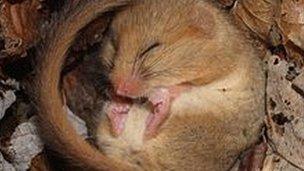Nibbled hazelnut nut leads to Ceredigion dormice hunt
- Published

The common or hazel dormouse spends at least half its life asleep
Villagers in Ceredigion are hoping that a carefully nibbled hazelnut found on farmland might prove it is home to a rare dormouse.
The creatures open the nuts in a particular way, which leads ecologists to believe one is hiding away in Betws Bledrws, near Lampeter.
There are now plans to monitor the area for the next two years to see if the nocturnal animals are nesting there.
Numbers of the once widespread species have fallen by 39% since 1992.
This makes it vulnerable to extinction, so it is protected under European law.
The hazelnut was found at Denmark Farm Conservation Centre. Ecologists working for a company called AECOM helped uncover the evidence.
"Dormice open hazelnuts in a very particular way," said AECOM ecologist Gareth Parkinson.
"They make a round hole in the shell of the nut and leave clear teeth markings on the outside of the shell whilst the inside has no marks and is very smooth.
"Hazel dormice used to be more widespread in the UK, but they are now rare and vulnerable to extinction in this country. This is an encouraging sign and we will now look to monitor the site over the next couple of years to see if dormice are nesting in the area."
Mr Parkinson was part of a team of ecologists from AECOM's Leeds office who spent a week at Denmark Farm Conservation Centre on a training course.
Denmark Farm is managed by the Shared Earth Trust as a conservation project to demonstrate how small changes in management of farmland can have significant benefits for biodiversity.
The centre regularly hosts ecological training courses and it was during one of these courses that a hazelnut was discovered which showed signs of being eaten by a dormouse.
AECOM has now donated 50 dormouse nest tubes, which will be installed around Denmark Farm.
It is hoped that, when the tubes are checked next year, there will be more signs of dormice on the site.
Angie Polkey of Denmark Farm said: "We were all very surprised but completely thrilled to find signs of dormice during one of our recent courses.
"It indicates that dormice may use a wider range of habitat than previously thought and setting up the monitoring tubes will help us establish how widespread this endearing little creature is on our nature reserve."